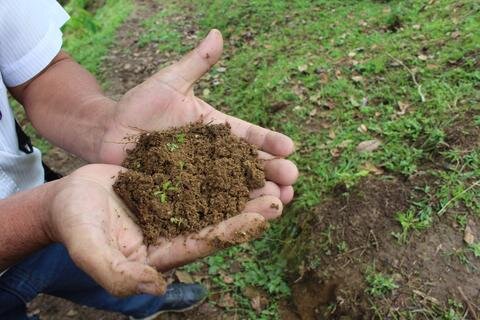
Where Does Coffee Come From? Part 2- The Farm and Mill
Where does coffee even come from? If you’ve ever asked this question from an agricultural standpoint, this blog is for you. Coffee has been cultivated for centuries and continues to spread into new parts of the world each year. This blog is the second in a series to describe your coffee’s journey from the farm to your cup. This blog will discuss the coffee farm and coffee processing methods in particular.
The delicious drink that we all know and love as coffee must undergo a significant journey to become the beverage we know it to be. The first stage in that process is coffee’s cultivation on farms all around the world. For coffea arabica, the species most commonly used in specialty coffee shops, the farms have to be at a high elevation with consistent rainfall and very fertile soil. Usually, coffee farms thrive at an elevation of 900 to 1500 meters above sea level. Regular rainfall throughout the year allows for consistent growth for the coffee trees. Farms thrive best when the trees are grown in fertile volcanic red earth or deep sandy loam soil. This typically means that mountainous regions are perfect for growing coffee given that the soil is soft and not rocky. Whenever these conditions are met it is a safe bet that there is a coffee farm somewhere in the area.

If you ever get a chance to see one of these beautiful farms, your eyes will be met with rolling hills of short coffee trees with red cherries and white blossoming flowers. One common misconception that is unhalted by ourselves and the coffee industry is that coffee is a bean. Coffee is actually a seed. It is the seed of a bright red coffee cherry that you might see on a budding coffee tree. The cherry is made up of three general parts- the skin, the mucilage (the ‘meat’ of the fruit), and the seed (or bean).
Once the growing season begins, the white flower blooms on the tree, which then yields these cherries. Initially they are green, but turn yellow, orange, and finally red as they ripen. Some coffee varieties, such as the Yellow Caturra, are actually ripe when yellow, as you might guess from the name. After ripening, the coffee is picked and ready for the next step of its journey.
The coffee leaves the farm with the cherry in tact, but it certainly does not arrive to the roaster this way. It has yet to undergo a critical part of the journey to your cup: processing. Coffee is processed in a variety of ways at the coffee mill and these processes have an integral impact on the natural flavors in the cup. Certainly the altitude, humidity, soil, fertilizer, and rainfall play a huge role in the taste of the cup, but those factors are either heightened or muted by the quality of processing stage.
What exactly does processing entail? Put simply- processing is the technique used to extract the seed from the cherry and dry it out for roasting. While this sounds very simple, it is actually not easy to do. One can make or break a harvest at this critical step.
There are generally four ways coffee can be processed. We will start with the oldest- the Natural Process. In this method, the coffee cherry is left on the tree for as long as possible, allowing the cherry to ripen and even ferment just enough for the seed to absorb flavor from the fruit. There is certainly such a thing as over-fermentation, which makes the natural process so tricky. There is a small window during which peak flavor can be achieved.
Once the fruit has sufficiently fermented, the cherries are sun dried, usually on raised beds, though sometimes it takes place on a rooftop like in Yemen. Once dried, the fruit is removed with the processing machinery at the mill. This is done in every processing method.
The Pulped Natural (or Honey) Process is predictably similar to the Natural Process. Again, the goal is for the fruit and seed to mingle for as long as possible. In this process, the skin of the fruit is removed leaving only the mucilage on the seed. These are allowed to spend time together drying in the sun, again promoting the transfer of flavor from mucilage to seed. Once enough time has passed, the mucilage undergoes the aforementioned final separation.
The Washed Process, which is the most common, is predicated on the idea that the fruit and seed have already spent enough time together. Once it arrives at the mill, the fruit and seed are separated and the coffee is washed (thus the name). Why would anyone want to separate the two so soon? There are a few reasons.
First, it is simply easier to do. As mentioned previously, Natural and Pulped Natural processing methods are high risk and high reward methods. Over or under fermentation are not always easy to avoid since each cherry processes at a different rate. Avoiding these extremes is also pretty labor intensive.
Second, a large constituency of roasters prefer washed coffees because they are typically easier to roast. Washed coffees are usually less dense and more consistent in the density that they do have, making it easier to roast consistently.
Also, as one might imagine, the flavor in a natural makes it a less stable bean. As it sits on the shelf unroasted, a natural coffee can lose its flavor and density, meaning a roaster may have to reconfigure the roast profile on the same coffee over time. Again, this is labor intensive in a way that some might consider not worthwhile.
Finally, there is the Swiss Water Decaf Method. This method is the standard way in which coffee is decaffeinated. After washing and processing, the bean is put through a series of high pressure machine washings that pull out 99% of the caffeine content.
After processing, regardless of method, the coffee is dried, rests, and then packaged. Many mills will sun dry their coffees on raised beds to promote even drying. Some producers, such as our Ethiopian coffee mill, will even rotate the beans every few hours to ensure the quality of each bean. We can definitely tell that they go the extra mile in the flavor.

Drying methods can vary from origin to origin. Our Yemen coffee mill dries the beans on rooftops, for instance. In some places like Indonesia, the coffee does not technically ever dry. On the island of Sumatra, for instance, it is far too humid to dry the bean fully, so they never dry completely out. This is referred to as the Wet-Hulled process, which some (like us) consider a subtype of the Washed Process.
Once coffee has been processed through any one of these four methods, the beans are packaged. Usually they are put into plastic bags specially designed to maximize freshness, which are sometimes vacuum sealed, further extending the shelf life. Once put into these bags, the coffee is placed in the traditional jute bags we all know and love. Depending on the part of the world, the jute bag either holds 60 or 69/70 kilograms of coffee. South and Central America will typically ship 69/70kg bags while the rest of the world generally sticks to 60kg bags.
After the jute bags are sewn up, the coffee is ready to ship. It is put into shipping containers and sent either to warehouses for storage, or sent directly to roasters. There it waits in climate controlled environments until it is ready for roasting, which we will cover in our next blog.
